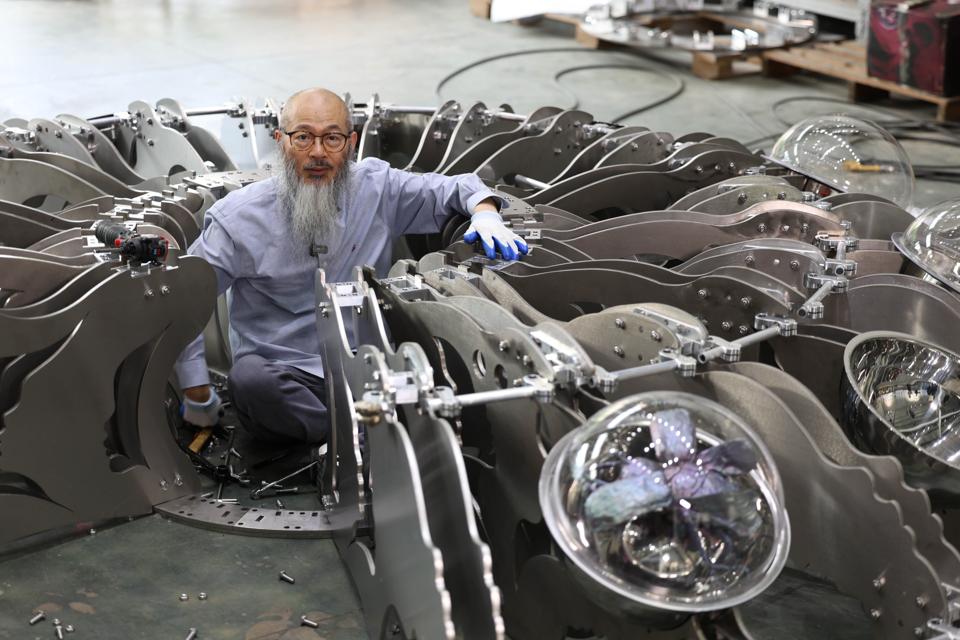Hong Kong artist Wallace Chan will stage his first dual-site exhibition with Vessels of Other Worlds, a continuation of his monumental titanium sculptures. The project will open May 8 to October 18, 2026, at the Chapel of Santa Maria della Pietà in Venice, coinciding with the 61st International Art Exhibition of La Biennale di Venezia. A parallel exhibition will follow at Shanghai’s Long Museum from July 18 to October 25, 2026, marking the artist’s 70th birthday.
This will be Chan’s fourth presentation of large-scale titanium works during the Venice Biennale. His series began with Titans in 2021 and Totem in 2022, both at Fondaco Marcello, followed by Transcendence (2024) at the Chapel of Santa Maria della Pietà, accompanied by the soundscape I Dormienti, by English musician, songwriter, record producer and visual artist, Brian Eno. That exhibition drew more than 30,000 visitors in three months, according to Chan.
Chan first rose to prominence as a high jewelry artist, pioneering the use of titanium for its lightness, strength and ability to shift in color. He transformed the material into multicolored jewels that mirrored—and often transcended—natural flora and fauna, as well as into elaborate large-scale adornments that fused Eastern philosophies, including his Buddhist training, with Western art traditions and even futuristic, sci-fi visions. These groundbreaking creations elevated the soft-spoken, mild-mannered artist to celebrity status in the jewelry world, with collectors worldwide seeking his work.”
For Vessels of Other Worlds, Chan once again collaborates with longtime curator James Putnam, recognized for his cross-disciplinary approach to curation. While many details remain under wraps, a spokesperson confirmed the Venice exhibition will center on three titanium sculptures inspired by the Olea Sancta—the sacred oils used in Catholic blessings. Positioned on the chapel’s altar, they will be paired with a video triptych that acts as a portal to reveal their counterparts in Shanghai.
The three works represent the cycle of life—birth, growth and death—and draw inspiration from Hieronymus Bosch’s The Garden of Earthly Delights. Suspended titanium forms, evoking oil drops in motion, will surround the central sculptures. “The idea,” Chan explained, “is to imbue the chapel with a sense of fluidity and transcendence.”
At the Long Museum, visitors will encounter the same vessels on a grander scale, standing seven, eight and ten meters high (23, 26 and 33 feet). The largest will feature a doorway leading into a kaleidoscopic mirrored interior, a reference to Chan’s celebrated gemstone-carving technique, the “Wallace Cut.” The Shanghai exhibition will also revisit earlier works from Titans, Totem and Transcendence, including Eno’s I Dormienti. “The idea,” Chan said, “is to create a dialogue that links the two cities conceptually and experientially.”
“Both Venice and Shanghai are closely tied to water—its changing states, its ability to hold, reflect and transform,” Chan noted. “Vessels of Other Worlds is my way of unfolding a tale of two cities through the reimagination of fluidity and form.”
The contrast between venues is striking. The Chapel of Santa Maria della Pietà, an 18th-century Baroque church famed for its Tiepolo ceiling, remains largely untouched, its faded walls bearing the marks of centuries of Venetian weather. By contrast, the privately owned Long Museum (West Bund), opened in 2014, is defined by its industrial concrete architecture and imposing scale.
By connecting the old Western city of Venice with contemporary Shanghai, Chan says he seeks to expand the presence of his sculptures across space and time, creating an experience that is physical, spiritual and transcendental.
“These vessels are containers of memory, spirit and transformation, sculpted from titanium, the material closest to eternity,” Chan said. “Like water, they hold what cannot be held—moments, emotions, the passage of time. By placing them in two distinct spaces, I hope to spark a dialogue between distant places and between our inner and outer worlds, inviting viewers to contemplate the cycle of birth, growth and death—and to imagine the other worlds that may lie beyond.”

